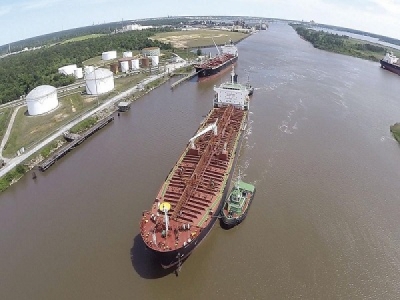
Posted on April 17, 2018
For over a century, the people of Jefferson County have paid an annual tax to keep the Sabine River channel in Southeast Texas properly dredged for ships passing through.
Now, the people of Calcasieu and Cameron parishes are being asked to do the same thing as leaders increasingly struggle to keep the Calcasieu Ship Channel from filling up with sediment.
Sponsored by Sen. Dan “Blade” Morrish, R-Jennings, legislation creating the Calcasieu-Cameron Navigation District received unanimous approval earlier this month in the state Senate before moving to the House.
It will later go before voters in the two parishes for final approval.
“It’s going to be a tough sell,” said Morrish, who has led efforts to start the tax district over the last year along with the Lake Charles Pilots Association. “There’s not going to be some new stadium at a college campus or a museum or anything that you could touch. This is about mud.”
But Morrish said there’s no question of the need for the tax district in order to save the channel and the 36,000 local jobs that depend on it.
According to a recent study by Baton Rouge firm CSRS, up to 46 percent out of every dollar is tied to the channel, a 68-mile man-made body of water.
The federal government through the Army Corps of Engineers funds channel dredging, but the Port of Lake Charles has been left holding a rather sizable bag when it comes to disposing of the dredged material.
The port is responsible for 25 percent of the construction costs for rebuilding existing disposal sites and acquiring new ones — a cost that could reach $80 million over the next 20 years, officials have said.
Dredging sites are also getting harder to find. Right now the port has access to storage for about one Superdome of soil. Over the next two decades, it would need to store the equivalent of 21 Superdomes.
The port has spent about $8 million on maintaining spoil sites since 2015 and committed $15 million through 2021, Morrish said. But that’s not enough to get a handle on the situation.
The real problem and what’s running the cost so high, he said, is the fact that spoil sites along the river haven’t been maintained for decades, causing dredged soil to pour right back into the channel.
“We’re to the point now where we’re chasing our own tail,” said Brett Palmer, president of the local pilots association. “We’re pumping it out, and it’s failing right back in.”
Just last year, he said, spoil sites saw 14 levee failures in a three-month period because of the area not being maintained. Mud is also coming back into the channel through pipes meant for decanting the water, and land is sliding off the banks into the river, covering oyster reefs and marine life, he said.
Palmer said channel maintenance is an issue the new tax district could address. The proposed district was modeled after the one in Sabine, which has managed to keep its costs reasonable and sustainable by continually maintaining its channel, he said.
“They’re so organized they even cut the grass in they’re spoil areas,” Palmer said of the Sabine-Neches Navigation District. “They have boots on the ground every day to where if there’s some issue with those spoil areas, they go out and fix it right away.”
The Calcasieu Ship Channel was formed by channelization of the Calcasieu River from Lake Charles to the Gulf of Mexico. Keeping the channel dredged and keeping dredged soil from falling back into the water is a major concern.
Palmer said his biggest concern is that problems in the channel will dissuade proposed liquefied natural gas export facilities from coming to the area.
“If we have an issue with one LNG ship and it becomes public, it’s going to kill every potential LNG project that was ever talked about,” Palmer said. “They’ll run from here.”
Already, he said, mud pouring back into the river has significantly slowed down the path of ships coming through as they travel through slush as “thick as a milkshake.”
Although many people have voiced their support of the district, including major industries along the canal, Palmer said, some feel the bill for channel repairs should fall to industries alone.
Others have suggested charging ships as they come in. But he said both of these alternatives would affect the competitiveness of the region and could cause ships to take their business elsewhere.
Morrish noted that industry will be paying much more than homeowners on the proposed tax.
Owners of a $109,000 home, the median price in Calcasieu Parish, would pay around $13 a year, Morrish said. Owners of a $200,000 home would pay around $62 a year.
If sufficient revenues are received from the property tax, annual payments would be made to the Cameron and Lake Charles ports, $500,000 each; the West Calcasieu Port, $300,000, and the Vinton Port, $200,000.
Source: American Press





